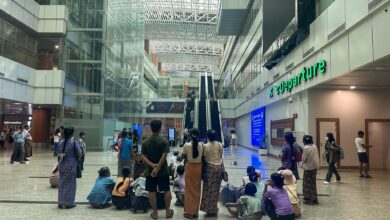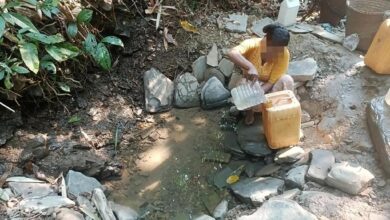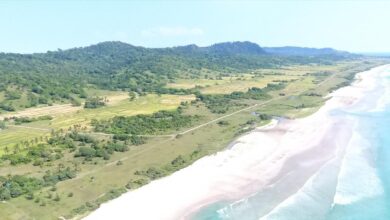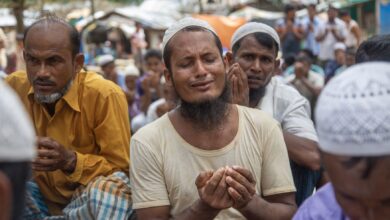
When four monks arrived in the central Sagaing Region village of Ngar Toet last month, they were accompanied by a group of gunmen, and together ordered all of the 250 households’ residents to gather in the local monastery.
One of the armed men then pointed his rifle towards the sky, opening fire until he ran out of ammunition, a villager said, one of many who spoke to Myanmar Now on the condition of anonymity about the October 24 visit.
“They yelled into a megaphone that we were not to go outside. They said they would shoot us if we ran and asked us to remain quiet,” he remembered of the meeting on temple grounds.
A locally known ultranationalist monk known as U Warthawa appeared to lead the group that arrived in the Kanbalu Township village that day. The 40-year-old had built a reputation for overseeing the formation of military-backed Pyu Saw Htee militias in Sagaing, a region where resistance forces—widely supported by the public—and those under the junta have been contesting for control since the February 2021 coup.
Armed and trained in combat techniques by the Myanmar army, the Pyu Saw Htee groups were initially made up of pro-military nationalists, veterans, or backers of the armed forces’ political proxy, the Union Solidarity and Development Party (USDP). They have been seen fighting alongside junta troops against anti-regime forces and participating in raids and arson attacks on villages throughout northwestern Myanmar.
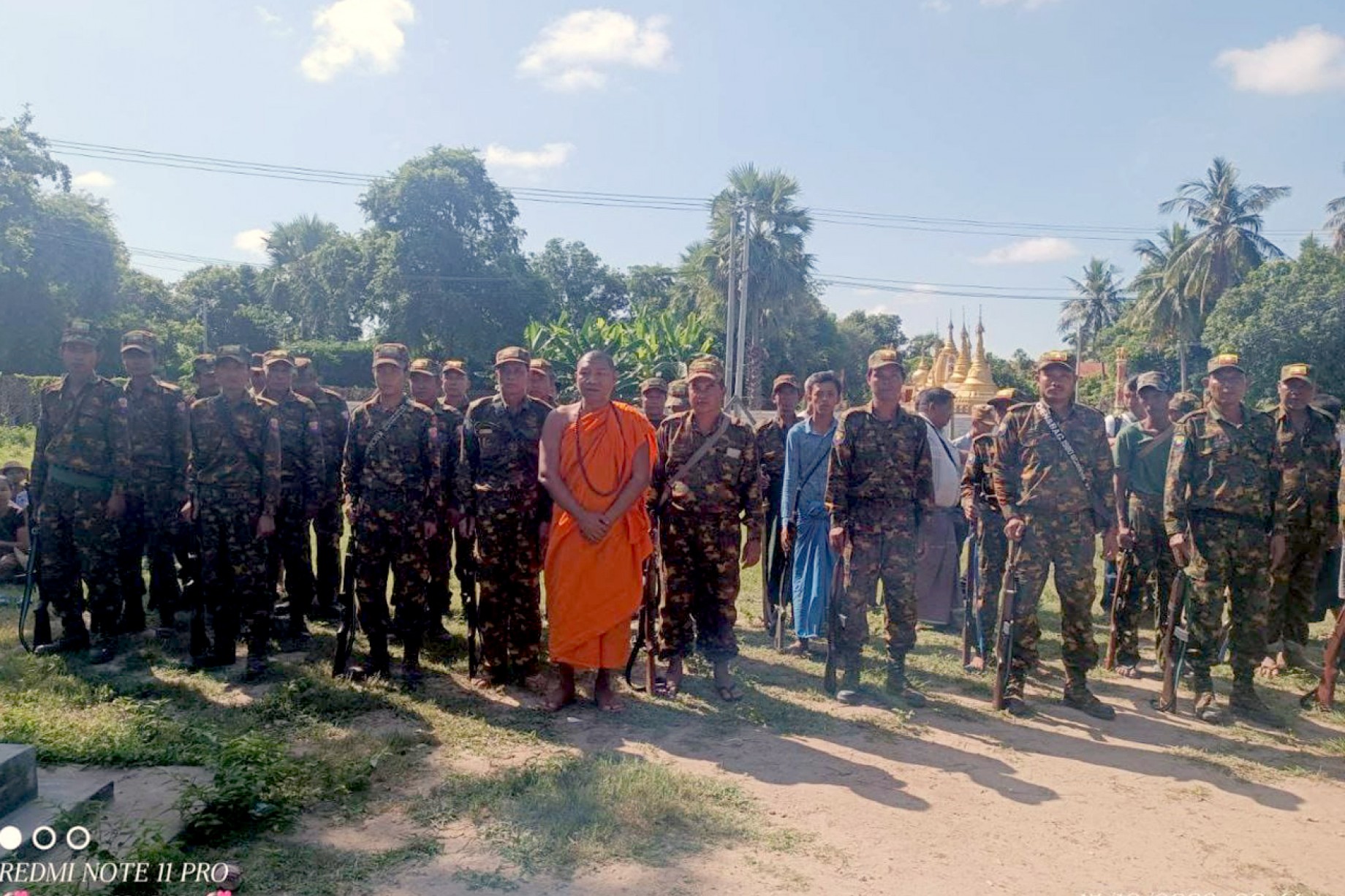
U Warthawa’s late October arrival in Ngar Toet was for the purpose of Pyu Saw Htee recruitment, locals soon learned. During the monastery meeting, the monk selected the names of 50 residents at random and ordered them to attend a two-week training to commence in five days, one that would prepare them to join the militia.
The gunmen later went door-to-door through Ngar Toet, recruiting a total of around 150 men to undergo the combat training for the Pyu Saw Htee, held at the same monastery.
“Those who didn’t get chosen were relieved,” said a Ngar Toet local whose name was among those who had been called. “Nearly all the ones who were chosen went to the training, by force.”
He was among the few who refused, quietly fleeing the village with his family and going into hiding.
Two others attempted to run away on November 1, but were unsuccessful. One was 36-year-old Aung Chanthar Htun—a former campaign organiser for the ousted National League for Democracy—who was killed by junta troops, according to a relative. The other, whose identity was not known, was recaptured. His condition was not known at the time of reporting.
Such training sessions typically conclude with the distribution of single-shot or automatic rifles, provided by the Myanmar military for the participants.
Locals speculated that Ngar Toet was selected as a training site due to its location, just two miles from the junta stronghold of Kanbalu town, and near the base of a tank battalion. One-third of the village’s residents were also historically supporters of the USDP and the military’s claim to political power.


Pyu Saw Htee funding as ‘disaster relief’
U Warthawa is an infamous and divisive figure in Kanbalu Township, serving as the abbot of a temple in the predominantly Muslim village of Hmaw Taw, where only 10 percent of the 500 households are Buddhist.
He was previously affiliated with Ma Ba Tha, a now-defunct Buddhist extremist network notorious for its attacks on Myanmar’s Muslim community.
Days before he arrived in Ngar Toet, he had received more than 4m kyat (US$1,900) in cash from the junta to buy food for some 160 Pyu Saw Htee members in Kanbalu and neighbouring Taze Township.
Soe Shwe Aung, the chair of the military council’s Kanbalu District Administration Department, handed the money to U Warthawa on October 20, according to letters exchanged between junta departments in Sagaing over the past two months. The documents indicated that the money, approved by the army’s regional administrative body, was taken from funds reserved for Kanbalu District disaster relief, local development, and monasteries.
Pyu Saw Htee groups have a strong presence in around 40 villages in Kanbalu, Taze and Kyunla townships, according to sources within the resistance. Villagers familiar with the militias in these areas say that members are provided with free uniforms and paid 170,000 kyat ($80) monthly, while leaders receive a salary of 210,000 kyat ($100).
While visiting communities in these townships earlier this year, U Warthawa declared that those who administered financial support to anti-regime groups including the People’s Defence Force (PDF) should be “eradicated.”
In an interview with Myanmar Now in June, U Warthawa defended his calls for demolishing villages determined to be aligned with the resistance movement, claiming that he was acting in the spirit of “angry benevolence.”
“I want them to be good people. The PDFs also belong to our national race,” he said at that time, a reference to the Bamar Buddhist supremacist philosophy to which he is known to subscribe.
‘Divide and rule’
Many of the armed resistance groups active in Sagaing report to the publicly mandated National Unity Government and are known to have received support, including training and arms, from the Kachin Independence Army, one of the most powerful ethnic armed organisations in the country.
While the military does not release information on its casualties in northwestern Myanmar, it is said to have suffered major losses in ambushes carried out by guerrilla fighters with advanced knowledge of the local landscape in Sagaing.
The Myanmar army has attempted to bolster its ranks with the formation of militias in the region, but its forces reportedly continue to be spread thin.
“As far as I know, there are at most a total of 30 to 50 junta soldiers and Pyu Saw Htee members in some townships in Sagaing. They are only able to guard the police stations and the cities,” Aye Chan, an army captain who defected to the resistance, told Myanmar Now.
Another defector and former captain, Zin Yaw, said that the building of civilian militias to deepen hostility between communities on the ground was an example of the “divide and rule” methods long employed by the Myanmar army to maintain its hold on power.
“It is a disgusting and fearsome strategy,” he said.
